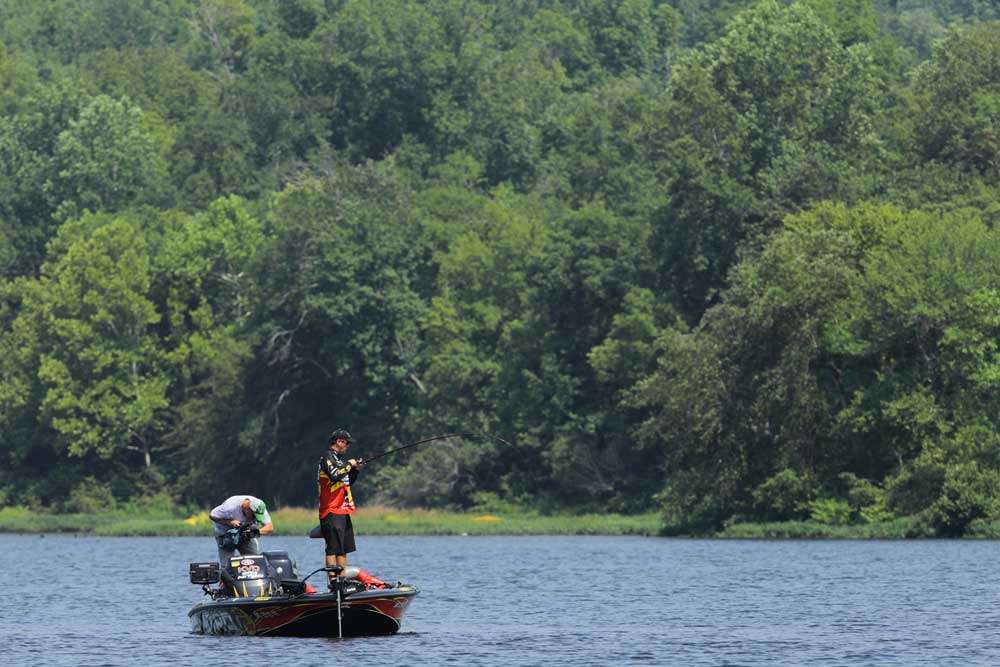
This is the time of year when you’ll find me employing power fishing tactics on the offshore ledges throughout the South.
As most anglers know, bass will school on the main lake, feeding of balls of shad throughout the day.
But there’s one period when action is best — when dam operators throw the switch to pull water through the turbines to generate electric power for nearby communities.
On some bodies of water, dam operators pull water about the same time every day and the fish get conditioned to that. They will feed the same time every day.
You can learn the generating schedule by visiting the power company’s website. I keep those websites on my smart phone and will recheck them throughout the day.
When the water is running, it moves the shad around, repositions the fish on the structure and works like a dinner bell.
Those feeding flurries can be short-lived, which is why power fishing is best. You can make more casts and catch more fish in a shorter period of time than if you’re dragging finesse plastics around on the bottom.
When the current isn’t on, your graph will show suspended bass; when the water is running, the bass will drop to the bottom on key areas of the structure and wait for the current to push the bait to them.
That’s when you want to be on structure that has current moving over it, funneling the bait to bass in the ambush mode. Long offshore points and river ledges are good bets, but don’t overlook shallow flats, either. Some of the best offshore places I’ve fished in summer have been extremely shallow, such as where the current blew over a shallow flat between an island and the bank.
Water clarity plays a role in bass location. Bass don’t feel as secure and can be harder to catch in the shallows if the water is clear, so you may have to look deeper. Or, if your lake is clear, check out the upper end that tends to have more color and holds more aggressive fish shallow.
When scouting a lake for sweet spots, I begin on the down-lake end and work up-lake so I can see how the current moves around bends and where it hits directly on structural elements.
If there is more current over one area than others, the bass will key on it when the water is moving.
I rely on my electronics while searching for potential areas. I’m looking at the Lakemaster map on my Humminbird chart for flats located near the bend of a river where the current hits hardest, then graph that area with my Side Imaging, looking for any high spots, ditches or other irregular features that would provide the bass an ideal ambush area.
I prefer to position my boat so that I am casting into the current and working my lure with the current flow across the structure.
Crankbaits are my favorite lures because they best resemble shad. That’s not to say other baits won’t work, but different sizes of crankbaits allow you to fish different depths and keep the bait banging on the bottom.
Of course, you can catch them on other baits, like a football jig that resembles a crawfish. There’s crawfish down there, too, and if presented in front of a feeding bass, he’ll hit it. But shad are the fish’s main focus this time of year.
Cover can dictate which lures are effective, but if I’m fishing a hard bottom, a KVD square bill crankbait is an excellent choice. If the water is deep, a Strike King Series 5, 6XD or even a 10XD might be better choices.
Other baits that are effective include a swimbait, Sexy Spoon or a 10-inch worm, all of which I work quickly across the bottom. I choose a lure that is most efficient at fishing that depth and the type of cover or structure on the spot.
I prefer heavier baits this time of year because they can be moved abruptly and fall faster to trigger more reaction strikes.
If I do catch one on a spot and can’t get another bite on the fast mover, I will try a drop shot, shaky head or jig.
And what if they aren’t moving water and the fish are suspended? Choose lures that stay in the zone of water the fish are using. For example, if they are suspended 15 feet down, I’ll opt for a crankbait that stays in that 15-foot zone longest. If that doesn’t work, I will use a swimbait or big spinnerbait that I can control at that depth, or rip a structure spoon off the bottom and above the fish and let it flutter down.
The main thing is to keep working and watch for more current. When the dam operators flip the switch to move water, the fish will get active and the bottom bite will be more productive.





